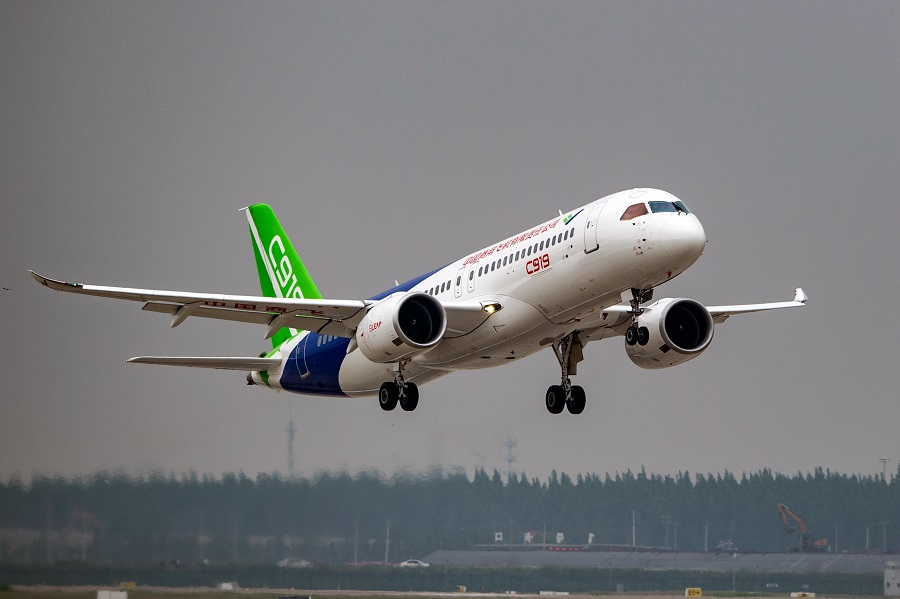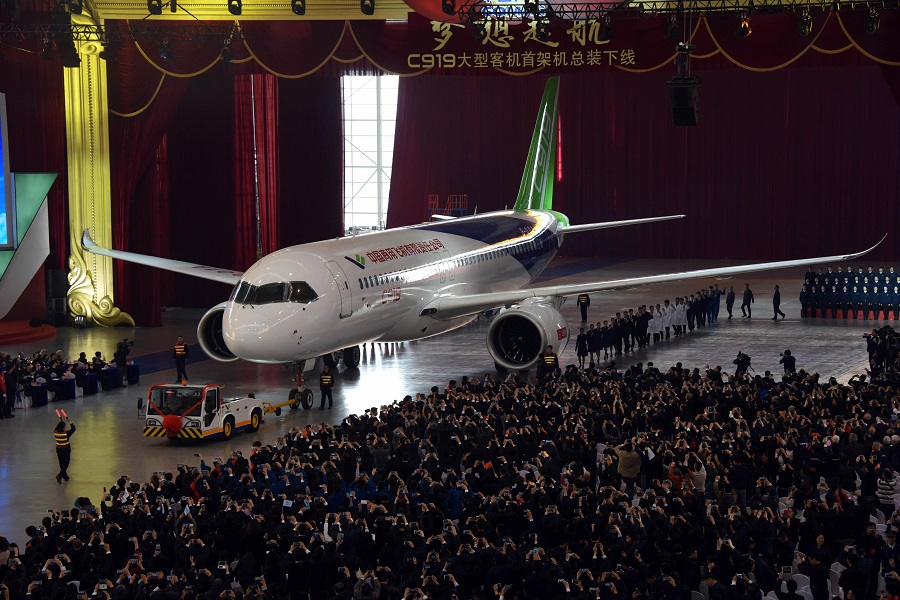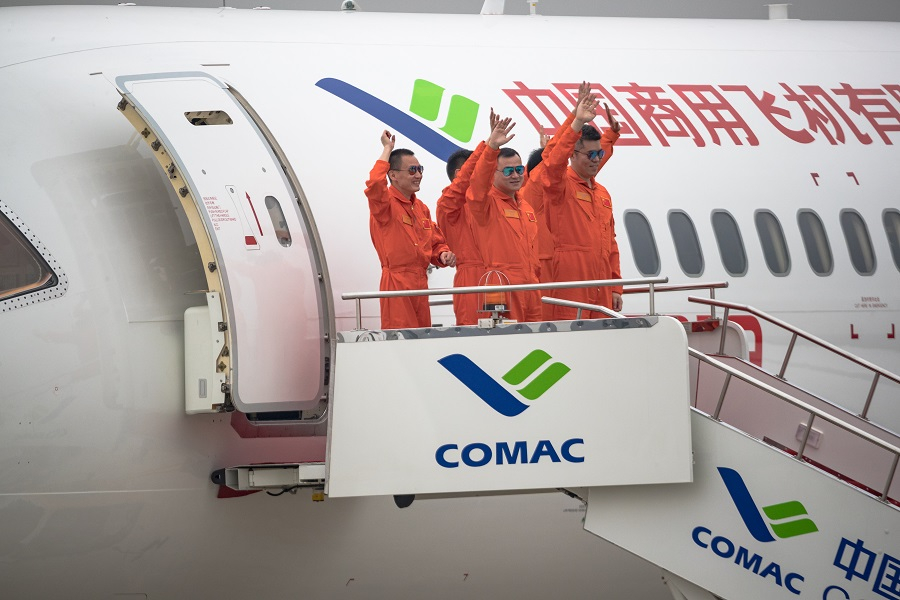After 10 years of research and development, China’s ”homegrown” large jet aeroplane, the C919, has taken wing and completed its maiden flight successfully, meaning that its manufacturer, the Commercial Aircraft Corporation of China (COMAC,中國商用飛機公司), is now on course to create some turbulence in the global high-capacity passenger aircraft market. After the first flight, the aircraft will have to complete extensive ground and flight testing, and it may be several years before the aircraft is officially cleared for service. If all this is new to you, you may be wondering: how did the name “C919” come about?What innovations have been adopted during its production?What tests were performed during its maiden flight?Rest easy, all will be answered below.
On May 5, 2017, the airspace above Shanghai’s normally busy Pudong Airport (浦東機場) was unusually clear. Meanwhile, everyone on the ground had their eyes glued to the skies and soon a white plane with a blue and green striped tail burst out of the clouds. It made a slow and confident touchdown, greeted by long cheers and applause from onlookers on the ground.
Thus concluded the test flight of the “homegrown large jet,” the fond nickname for C919, China’s first self-developed large civilian jet aircraft. Its success signifies C919’s transition from R & D to application. As of 2016, China had three large aircraft models - referred to as the “Three Musketeers” - Xi'an Y-20 (運-20) the large transport craft; AG600, the amphibious aircraft, and C919, the large passenger aircraft.

A “large aircraft” typically refers to transport-type aircraft with a lift-off weight of over 100 tonnes. It also includes military aircraft with a range of 3,000 km, or civilian aircraft that seat 100 or more passengers. Due to different development levels within the aviation industry in various countries, the term “large” is, on the whole, a relative concept. While passenger vessels with over 150 seats are considered “large aircraft” and those with 100 seats or fewer are considered feederliners in Mainland China, the global aviation system usually defines “large aircraft” as vessels with over 300 seats, which shows the difference in concept.
Ten years in the making
To be precise, C919 should be categorized as a short to medium-haul, twin-engine, narrow-body civilian transport vessel. Produced by COMAC, it has 158 to 168 seats at its standard configuration and a flight range of 4,075-5,555 km, similar to the Airbus A320 and Boeing 737. C919 has come a long way: starting as a major scientific project on large aircraft officially established in 2007, rolling off the final assembly line at COMAC’s assembly centre in 2015, and finally getting off the ground at Shanghai Pudong Airport in 2017 - ten years had elapsed.
How the name C919 came about is also interesting: C is the first letter in both “China” and its maker’s acronym “COMAC”; it also signifies the company’s ambition to enter the market for large passenger aircraft and stand as the equal of Airbus and Boeing, such that the leading trio would become known as the “ABC” of the aircraft manufacturing industry; the number 9, pronounced “jiu” in Chinese, means “long-lasting,” while “19” underscores the 190-seat-maximum capacity of this pioneering large passenger jet.
All parts of C919 were designed by China: parts like its nose, fuselage, tail and wings were supplied by enterprises like Chengdu Aircraft Industry Group (成都飛機工業集團), Hongdu Aviation Industry Group (洪都航空工業集團), Shenyang Aircraft Corporation (瀋陽飛機工業集團) and Xi'an Aircraft Industrial Corporation (西安飛機工業集團). Other key components such as the engines and landing gear, while designed by China, were outsourced to overseas enterprises for production. To some, it would seem that China merely created the “shell” of the aircraft, when in fact it is a common practice in the civil aviation industry to conduct design in-house and purchase components from manufacturers around the world. Even Airbus of Europe and Boeing of the United States, the leading duo in the industry, outsource production of aircraft components to manufacturers in different countries and only perform the final assembly in-house. Boeing 787, for instance, consists of engines and landing gear manufactured in the United Kingdom, wings made in Japan and Korea, and rudders made in China; all are then transported to Seattle for assembly. China’s success in independent completion of system integration, a key technology, is a breakthrough and sign of progress for its fledging aircraft manufacturing industry.

Several other notable technical highlights of the C919 model include: a supercritical wing design that reduces resistance and thus fuel consumption; lithium-aluminium alloys and composites with higher specific strength and stiffness as well as higher fatigue resistance, and advanced electromechanical systems. These features help make the C919 a “green” plane that is more energy-efficient and economically beneficial.

Soaring high
When it comes to a maiden flight, the burning question is: who will do the flying?
It is a task in which pilots take immense pride, though the responsibility and risk they have to shoulder are great. Test pilots must be familiar with the aircraft’s performance and be able to verify its parameters under all kinds of extreme flight conditions, hence the risk is greater compared to flying regular airline flights. COMAC selected its test pilots based on their performance in various selection processes including interviews, theory, skill tests and psychological evaluations. The qualifiers formed a team of five with Cai Jun (蔡俊) as captain, Wu Xin (吳鑫) as co-pilot, Qian Jin (錢進) as the observer and Ma Fei (馬菲) and Zhang Dawei (張大偉) as the vessel’s engineers. Among them, Cai Jun and Wu Xin had both logged 10,000 hours of flight time each while Qian Jin had logged over 22,000 hours of flight time. They performed the final inspection of C919 prior to its maiden flight and helped the “homegrown large jet” make its first grand appearance in the blue skies.

What else needs to be done before a test flight?
After the aircraft comes off the assembly line, there is much work to be done prior to the test flight such as mock flights, gliding tests, trying out different modifications, performing ground tests and obtaining a flight permit. Gliding tests are conducted at slow, medium and high speeds to gauge how the aircraft’s structure and avionics system perform under the stress of taxiing-induced vibrations. They also ascertain that its taxiing motion characteristics and braking efficiency are satisfactory.
Having completed all gliding tests at the end of April 2017, C919’s first flight was scheduled for the afternoon of May 5.
First flight: more than just take-off and landing?
C919 took off at 2 pm and flew for over an hour. The test flight was conducted in five phases which included a ground inspection phase, a climbing phase (during which functions of the aircraft’s various systems were tested) and, once the aircraft had reached its designated airspace, the administering of various tests on the aircraft’s flight performance under different conditions. The aircraft was then brought to an altitude of 10,000 feet, where it simulated approach, landing and takeoff on a hypothetical runway at an altitude of 8,500 feet. Finally was a return and landing phase, after which the aircraft’s rudder was inspected for greater-than-normal deflection. All these tests must be satisfactory for the test flight to be considered a success.
The landing gear is usually not retracted during an aircraft’s first flight as the priority at this point is making sure that the aircraft can takeoff and land safely. Given the short flight programme, it makes no difference whether the landing gear is retracted or not. On its maiden flight, C919 was also accompanied by a “sidekick” - a chaser plane charged with real-time monitoring of the test flight vessel, recording its flight data, and taking photos and videos to ensure the test flight vessel’s safety during the process.
Upon C919’s return and landing at Pudong Airport, Wu Guanghui (吳光輝), the chief designer of the C919 programme, walked up the gangway, clearly in an emotional state, and embraced Cai Jun the pilot.

No pain, no gain
C919’s success in its test flight does not mean that it can go into service right away. This is just the beginning of a whole series of further flight tests the aircraft must complete - thousands of on- and off-ground tests of various aspects of its performance, followed by the airworthiness certification process - with airworthiness defined as the aircraft’s suitability for safe flight under both reasonable and challenging conditions. During the process, C919 will supply design, production and testing data for inspection, as well as run test flights in various weather conditions to validate its safe performance. If all goes well it may then enter service. Take as an example ARJ21-700, a regional passenger jet developed by COMAC earlier. It underwent 8 years of flight testing, seeking out locations with the most extreme weather conditions in China and abroad. Tests were run to ascertain how performance was affected by icy conditions and the crosswind validation test (which entails countering sidewinds while flying). Indeed, ARJ21-700’s flight test experience proved useful to C919.
Though C919 has yet to go through years of testing and certification processes, to date it has already received over 800 orders from numerous local and overseas companies. Numerous commentaries praised it for showing a high level of technological capability and remarked on its bright outlook. According to a Wall Street Journal article, the successful maiden flight of China’s C919 is considered a “technological milestone.” If all goes as planned, C919 will be China’s latest breakthrough in its efforts to upgrade its manufacturing capacity in sectors including robotics, computer chips and electric cars. The New York Times described the public maiden flight of C919, the first Chinese-built passenger jet, as China’s commercial aerospace dreams taking wing. For a developing nation that just 40 years ago was mired in poverty, C919’s maiden flight symbolizes China’s emerging industrial might, and its dream of dominating a new technological era.
Perhaps, in the not too distant future you, too, will get a chance of flying with C919 during your travels.
References:
Homegrown Large Aircraft C919 Takes Its Maiden Flight Today, Overall Domestic Content Ratio of Plane Over 50% (國產大飛機C919今日首飛 整體國產化率達50%以上) gmw.cn (光明網) May 5, 2017
What’s Special about China’s Homegrown Large Aircraft C919? (中國國產 C919 大飛機有咩特別?) Weekend Weekly (新假期週刊) May 8, 2017
Maiden Flight of Homegrown Large Aircraft C919 Marks New Era for Civil Aviation in China (國產大飛機C919首飛 開啟中國民航新時代) huaxia.com (華夏經緯) May 5, 2017
C919 Receives Glowing Reviews from Foreign Media for Maiden Flight Success: Taking China’s Aviation Equipment Manufacturing to New Levels (外媒熱評C919成功首飛:中國航空裝備製造水平邁上新台階) thepaper.cn (澎湃新聞) May 6, 2017



